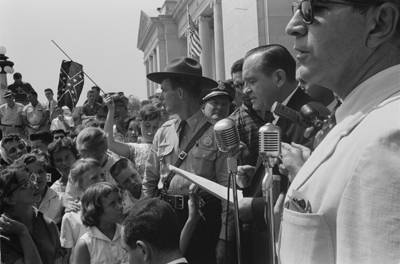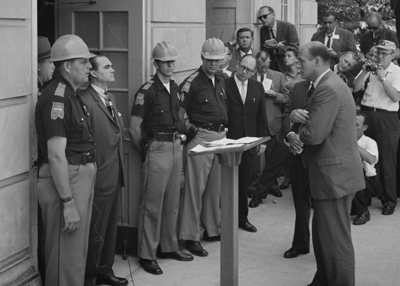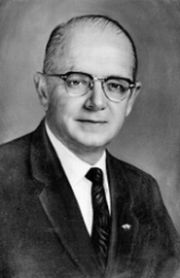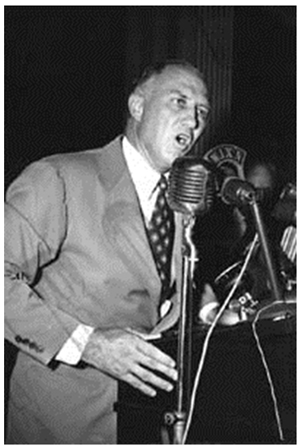Excerpt from Speech of Governor Orval E. Faubus,
September 18, 1958

Governor George Wallace of Alabama famously blocked the way of two African-American students at the University of Alabama in order to prevent them from registering. After a confrontation with federal marshals and the Alabama National Guard (who had been federalized), Wallace stood aside.
Below is a picture of Governor Wallace defiantly standing at the door of the University of Alabama while being confronted by Deputy U.S. Attorney General Nicholas Katzenbach. News reporters and members of the National Guard stand nearby.
Click the picture to see what Governor Wallace had to say about racial integration.
Excerpt from Gov. Wallace's 1963 speech regarding segregation

Lester Maddox of Georgia was a segregationist who owned a restaurant in Atlanta that, despite the passage of the Civil Rights Act of 1964, refused to serve African Americans. He maintained that he would rather close the restaurant than serve "black people." Maddox was elected governor of Georgia in 1966. As governor, Maddox refused Martin Luther King, Jr. the honor of lying in state in Georgia's capitol after King's assassination.
Click the picture to see what Governor Maddox had to say about discrimination.
Slansky, P. (2008). Idiots, Hypocrites, Demagogues, and More Idiots: Not-So-Great Moments in American Politics. New York: Bloomsbury Publishing.

In addition to governors, members of Congress from the South supported segregation. Some southern Democrats even broke away from the Democratic Party to form the Dixiecrats, a political party based on states' rights.
These Congressmen said that states should be able to decide the question of segregation and that the federal government should not be involved. South Carolina's Governor Strom Thurmond ran for president as a Dixiecrat in 1948 and actually won the states of Alabama, Louisiana, Mississippi, and South Carolina.
Several southern Congressmen drew up what became known as the "Southern Manifesto," a document meant to answer the Brown v. Board of Education ruling. Below is a photo of Strom Thurmond giving a public statement.
Click on the photo to see a portion of the "Southern Manifesto."
This interpretation, restated time and again, became a part of the life of the people of many of the States and confirmed their habits, traditions, and way of life. It is founded on elemental humanity and commonsense, for parents should not be deprived by Government of the right to direct the lives and education of their own children."
Excerpt from "The Southern Manifesto", Congressional Record, 84th Congress Second Session. Vol. 102, part 4 (March 12, 1956). Washington, D.C.: Governmental Printing Office, 1956. 4459-4460., The Strom Thurmond Institute.



